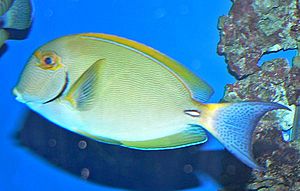Dussumier's surgeonfish facts for kids
Quick facts for kids Dussumier's surgeonfish |
|
|---|---|
 |
|
| Conservation status | |
| Scientific classification | |
| Synonyms | |
|
The Dussumier's surgeonfish (scientific name: Acanthurus dussumieri) is a type of ray-finned fish. It is also known as the eye-stripe surgeonfish or the ornate surgeonfish. This fish lives in the warm waters of the Indo-Pacific Ocean. It can grow up to 54 centimeters (about 21 inches) long, but most are around 35 centimeters (about 14 inches). Sometimes, these fish are kept in home aquariums.
The name dussumieri was given to honor Jean-Jacques Dussumier. He was a French explorer and trader who lived from 1792 to 1883.
Contents
What Dussumier's Surgeonfish Looks Like
Dussumier's surgeonfish has a body that is deep and flat, like an oval. It can grow quite large, up to 54 centimeters (about 21 inches). Its head is small, with eyes that stick out a little. The mouth is small and shaped like a beak, with pale, puffy lips.
The fish's body feels smooth because it's covered in tiny scales. But like other surgeonfish, it has two sharp, blade-like scales near its tail. These are called "scalpels" and are found on the caudal peduncle (the narrow part connecting the body to the tail fin). The fish can fold these scalpels flat or raise them to protect itself.
Both the top fin (dorsal fin) and the bottom fin (anal fin) are long. The fins on its sides (pectoral fins) help it move and stay balanced. The throat of the fish is blue. The rest of its head has many blue or gray-blue lines. The body is light brownish with fine, wavy, gray-blue lines running along it.
There is a wide orange stripe above its eyes. A thin orange band also runs along the base of its dorsal fin. The sharp, scalpel-like scales are white and have a black spot around them. The tail fin is shaped like a crescent moon. It is dark blue with black speckles, except for a pale area at its base. This fish is one of the biggest surgeonfish species, along with the elongate surgeonfish and the yellowfin surgeonfish.
Young Dussumier's surgeonfish look different. When they are very young, they are grayish with yellow and black tails. As they get older, their bodies turn dark brown. Then, as they grow even more, their body color becomes lighter. The wavy lines and face patterns start to appear.
Where Dussumier's Surgeonfish Lives
This surgeonfish is found in many places across the tropical and sub-tropical parts of the Indian Ocean and the West Pacific Ocean. Its home stretches from East Africa all the way to southern Japan, Indonesia, and eastern Australia. It can live in waters as deep as 130 meters (about 426 feet).
You can find these fish in different underwater places. They live in lagoons, on coral reefs, and on the slopes of reefs. They also live in areas between reefs that have sand, rubble, or rocks on the bottom. Young fish and young adults often stay close to the reefs.
What Dussumier's Surgeonfish Eats
Dussumier's surgeonfish mostly eats algae and detritus. Detritus is tiny bits of dead plants and animals. They eat the thin layer of algae that grows on rocks and other surfaces. Their diet also includes tiny plant-like organisms called diatoms and small particles floating in the water, known as plankton.
Scientists have not studied much about how these fish reproduce. Adult fish usually live alone or in small groups. However, young Dussumier's surgeonfish often swim together in large groups called shoals.
See also
 In Spanish: Acanthurus dussumieri para niños
In Spanish: Acanthurus dussumieri para niños



